A Legacy For Life Lived
I don’t think that we should ever lose sight of some basic but very interesting realities with regard to the craft of hand-making furniture and other woodwork. How often do we fail to understand that the joints we use today have been with us for centuries and that despite interesting developments in technologies no new joint exists that didn’t exist in one version or another 200-300 years ago? Dowels, biscuits and dominoes, of course, are not technically joints in the same way fastenings like inserts, fixing plates and screws in sloped holes don’t qualify as joints and joinery either. Generally, these third- party components are simply developments designed for speed and to replace both joinery and the skilled craftsmanship of old, not actually join it, if you will. Here’s another interesting truth too. No new hand tool exists that didn’t exist in one form or another 300 years ago. By that, I mean that whatever we have now we had in some different form in the past. I think a good example of what I’m suggesting could be the Shinto saw rasp. Is this tool with its saw teeth the same as a rasp or file or is it a completely new tool? Can the way it is made and the outcome in its finished form determine it to be a completely new tool? Is it the action of use that determines its name? Who knows? Try googling the name Shinto to find the maker’s site and you will end up studying a Japanese religion or on a hundred seller’s sites selling it under the title ‘Shinto Saw Rasp’. Shinto separates the Maker’s name and hybridizes saw and rasp into one name sawrasp. Of course, no one should be deceived by the title. It does not saw wood as such but it does capitalise on both the use of teeth as cutting edges and rasp as in a barbed plane.
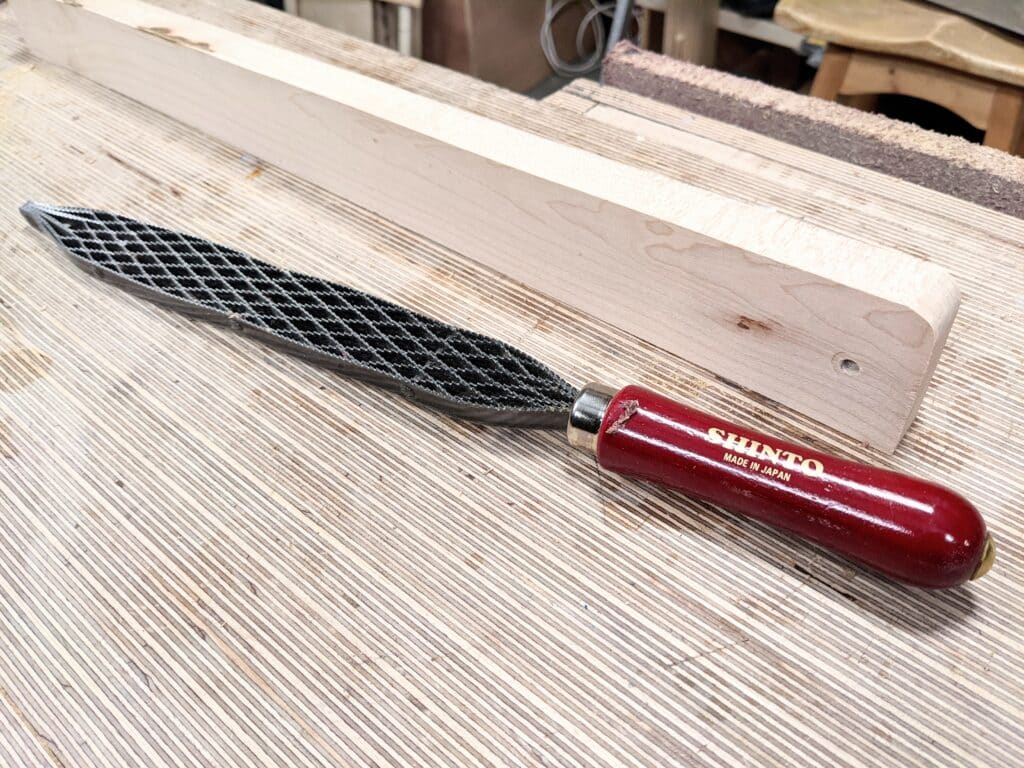
The manufacturing procedure created a method of making something to work with that actually gave us a good alternative tool that worked well at a fraction of the cost of a hand-stitched rasp. We then gained from a mass-made tool that could be made and boxed up in a matter of seconds with no human hand touching anything more than a machine’s start and stop button. The work needs no more input then than a man or a woman watching a quite skilless process that parallels most saw-making with stamped-out teeth, machine-filed cutting edges all as tap together parts with a couple of screw bolts or rivets to hold things in place. A Shinto is a pressed-out framework of saw teeth in a length of steel banding crimped into a diamond pattern with rivets holding the whole in place and requiring no skilled metalworking. It’s two-sided, fine and coarse teeth, giving us two rasps in one, making it a great strategy for fast stock removal followed by fine refinement in a single tool simply by flipping the rasp over. It was indeed a truly ingenious and brilliant idea that created a rasp-type tool that worked as a tool almost equally to a bona fide hand-stitched cabinet rasp at a tenth of the cost (shop around I have found £28 ones for as little as £13 without eBay or Amazon intervention).
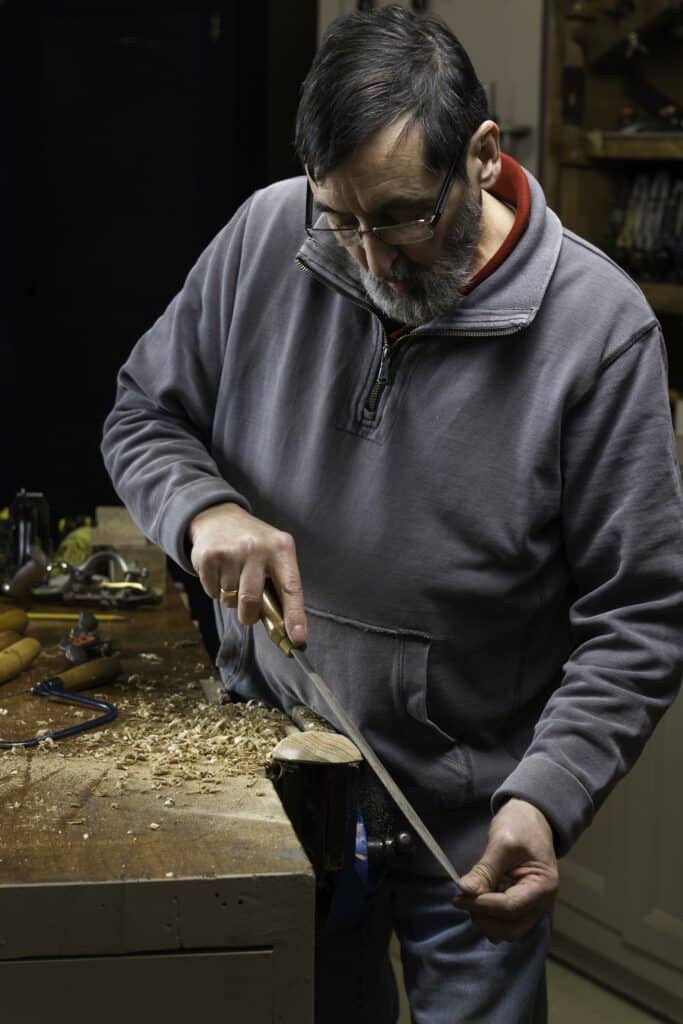
What Shinto has is something every toolmaking company dreams of designing and engineering. If they could come up with one that had a round face too they would be on another winner and though no one is doing it it is not at all complicated to do. I have already worked out what that would take and how that could be done. A hand-stitched rasp on the other hand produces the same or better work but takes many years to master the skills of making such a tool. A hand-stitched rasp gives its user a level of quality, control and accuracy no other hand tool can match and does so with a consistency that is repeatable in every version made. The man stands or sits and stitches the steel for half an hour or more per tool depending on the number of stitches per square centimetre, decides on the pattern and the number of stitches per distance travelled and records the ‘fingerprint‘ of his making such a tool in the outcome of his work. This truly sets him apart in the art of tool-making simply because his hands, mind and body deliver all the energy and direction and no machine can replace these skills with the same qualities he/she perfects. Such skilled making defies engineering, in the same way, blacksmithing a blade from hammered steel does. There is no dialling in synchrony as with machining planes or the chisels of a mass maker and no rotary cut governed by CNC seems able to quite approach the skills of a hand maker who master the art of hand making. Pure skill is earned and worked for by patient makers in the making.
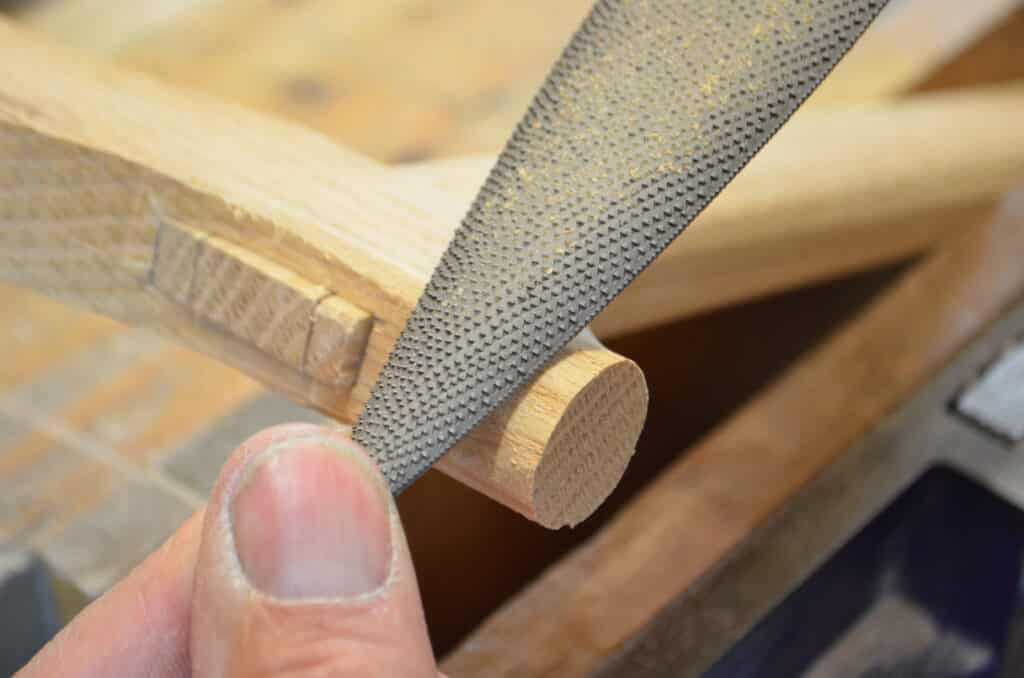
I wanted to spend a little time on that just to show we have a low invention rate in hand tools in three centuries and I rack my brain to think through to find something new in hand tools. In the past, we had wooden tools that worked as well, and much better than most of the all-metal versions. None of them were rejected because they didn’t work and work extremely well, it was the introduction of mass-made cast metal versions that changed the game. Cheap methods of making the main body displaced the skilled makers cutting in the throats, squaring up the soles and sides with hand planes and much more. Waiting four years and up to a decade for wood to fully season before production could begin was suddenly eliminated. Even so, it took almost a half-century to transition from the realms of skilled planemaking to the bolt-on assembly of soulless parts in the planes we know today. Why? Because no matter what you think, compared to a wooden sole, all metal planes stick to the wood unless you lubricate or wax them from time to time as you work a surface I cannot think of a wooden hand tool that was replaced because the metal versions did better except possibly the shoulder plane as more a luxury item rather than an essential one for most woodworkers–perhaps a plane or two like side rebate planes possibly.
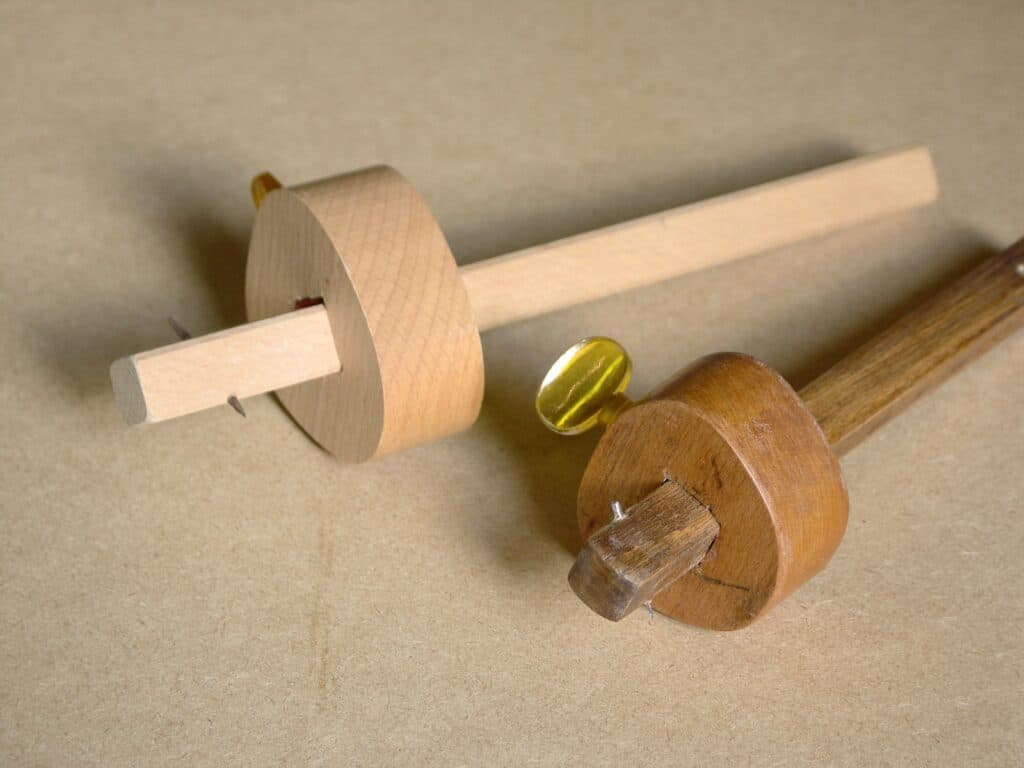
Above is another example: why have we tolerated angular marking gauges that are awkward and really quite uncomfortable? Then too, why did Stanley think that they could fob us off with their plastic versions? It’s because they can get away with it when there is no competition there is no change.
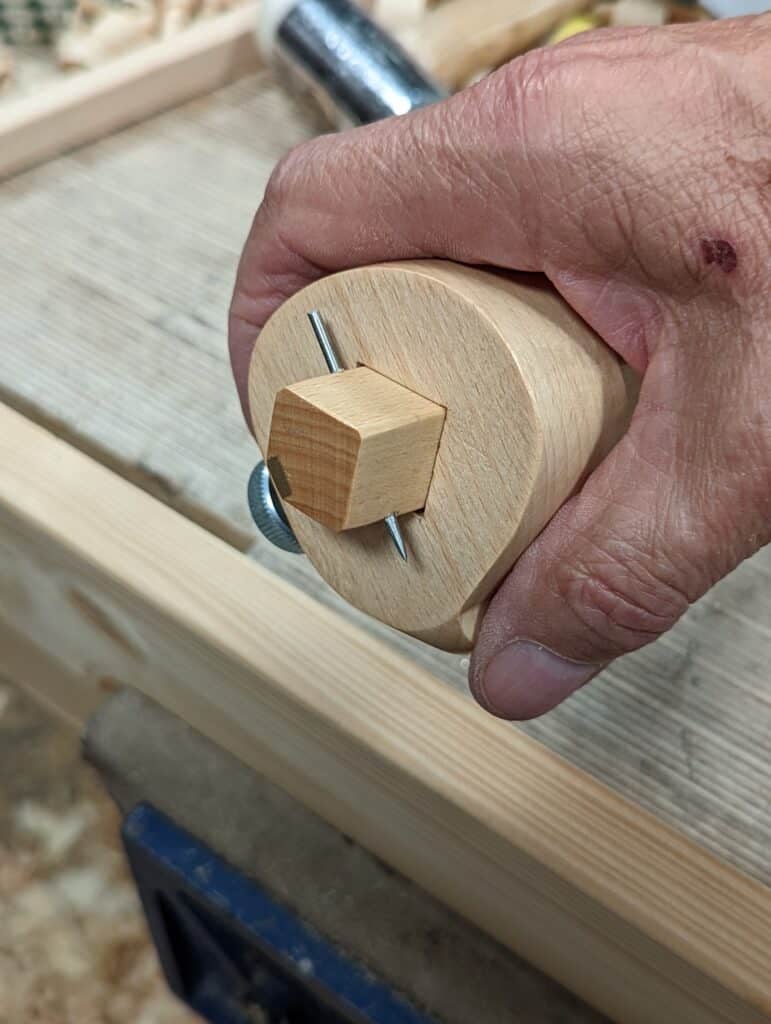
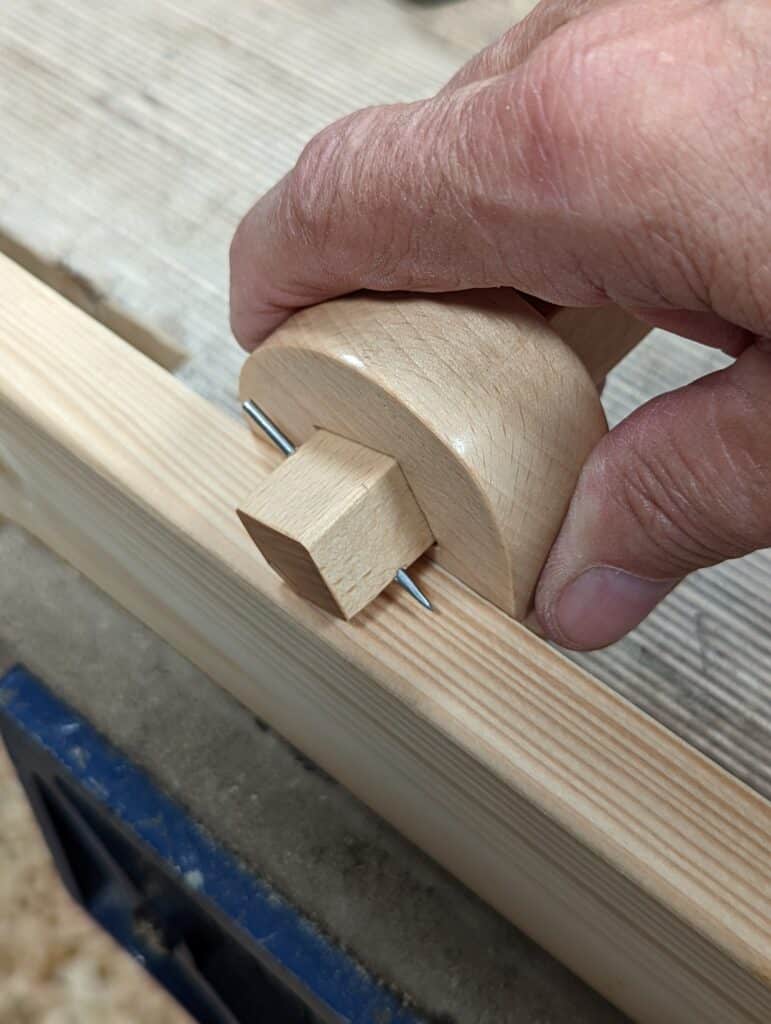
But mostly I am talking about wooden-bodied bench planes and spokeshaves and planes like tonguing planes, compass planes, curved-both-ways planes. Of course, no metal plane could or did ever successfully replace a vast range of rebate and moulding planes, over 300 of them. It was the power router that ousted the moulding plane range in the same way machines displaced most hand tools altogether. I do not believe that hand toolists like myself refuse machines and machining because they live as so-called Luddites. This is a mere insult and nothing less. We do what we do for a wide range of really exceptional reasons not the least of which is we reserve our right to literacy in skilled working and making; we love the concept of becoming and being fluent in the language of handcraft and enjoy the high-demand handtool woodworking requires of us. It’s dead simple really. Hundreds of thousands of woodworkers including myself choose to now enjoy a different way of life that gave us access to a health-and-wellbeing lifestyle we could gain in no other way. If the handwork, the methods and techniques that work so very effectively, make me a Luddite and give me such good physical and mental health along with peace of mind and contentment then bring it on all the more, I will take the name willingly.
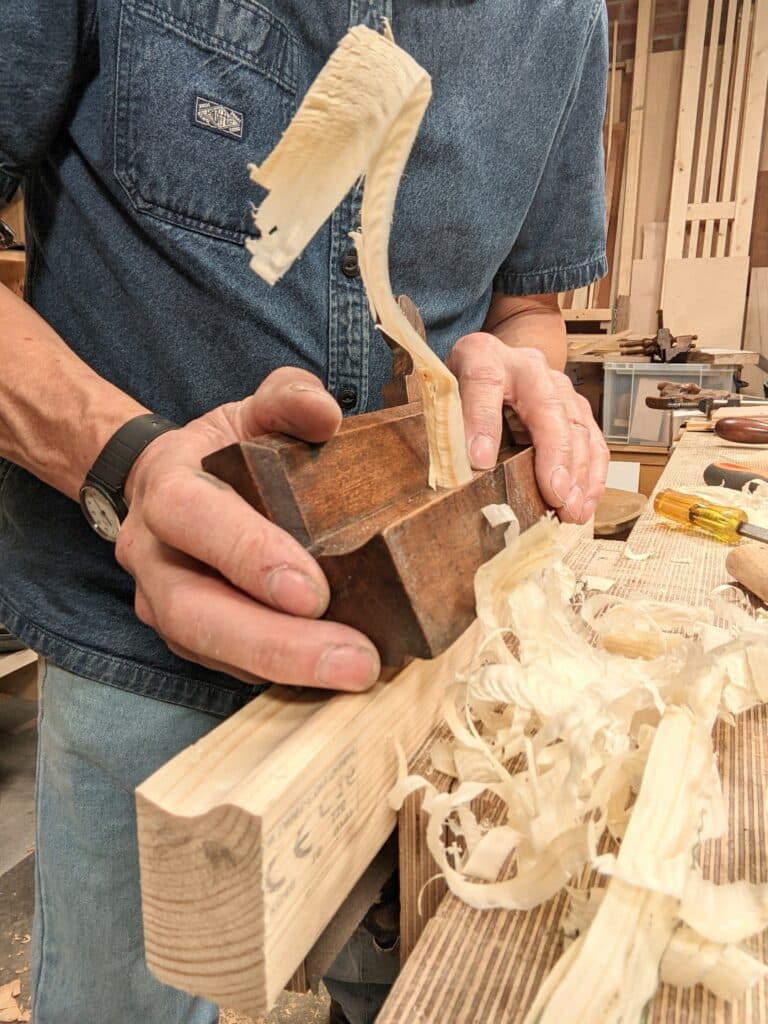
Thousands of woodworking joints have been devised and developed by inventive joiners through the centuries. The majority of these joints will continue to go unused and we furniture makers rely on surprisingly few, a handful really. Why? Well, many of them are quite specialist and now obsolete through other developments in metal and plastic, but mostly they are relatively impractical for furniture making. Outside of the specialist realms, most of them are unnecessary, time-consuming to make and often cannot be applied to the work we are engaged in. Even tradition can become whimsical in the presence of a changing culture. That said, making a complex and obsolete joint might present intellectual and physical challenges and also have a therapeutical value and thereby find its place in an individual’s life.
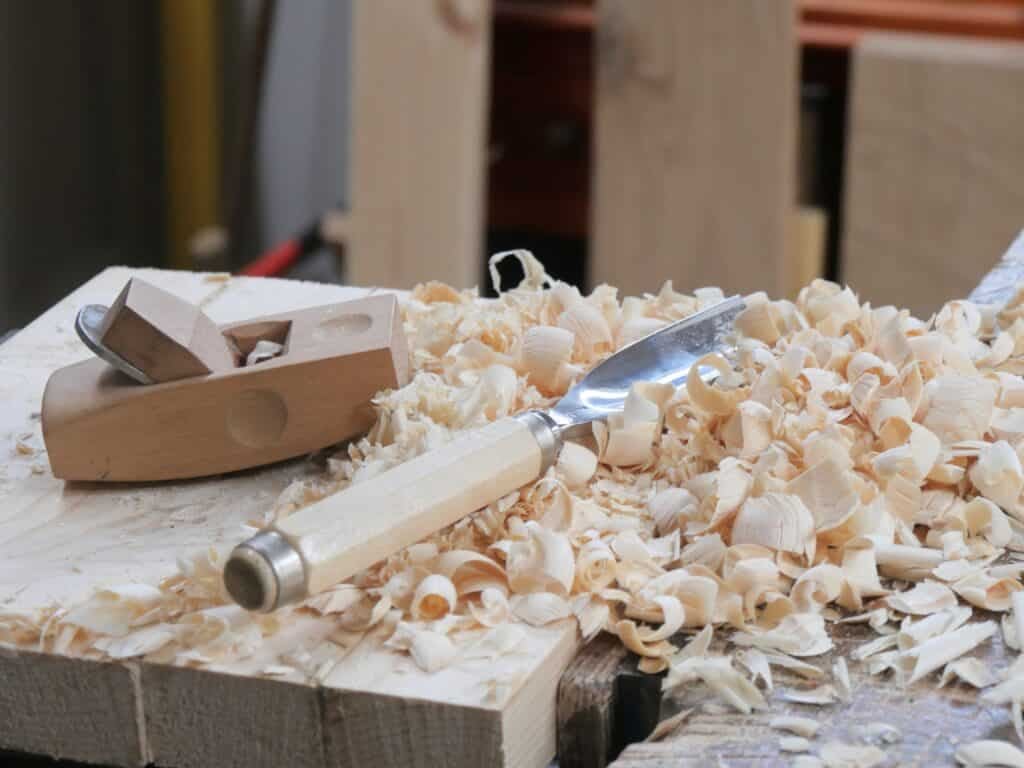
The basic ingredient for my teaching woodworking has always been to keep simple what is always simple. I began almost three decades ago with this undergirding. Before that, when I started to take on apprentices one or two at a time for a focused year or two, it always seemed complicated because most people factored the essentials as including machines. The course for every new starter was the same and remains so. I also taught a couple of dozen local children in the evenings from 7-9 pm three or four evenings a week from February through November.
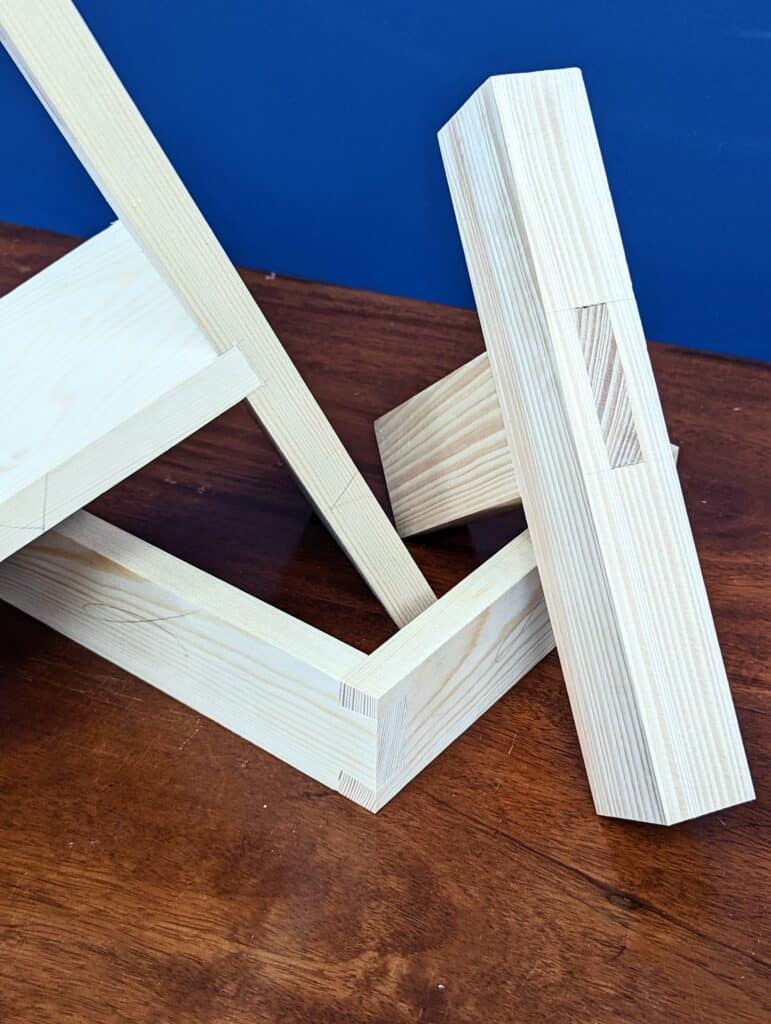
Three joints with two or three variations give us the lifetime joints we return to every day through life as a maker. Does this not strike you as an amazing simplicity without any hint of being simplistic? Adding machines takes a huge investment and a prohibitively massive footprint in our precious garage, shed, loft or cellar space. The answer to real woodworking suddenly becomes so clear and straightforward when you see it for what it really is. This is the legacy left to us. Now think the more of this if you will. Every exercise move you might make in a gym, every weight lifted, step taken, muscle moved, stretched and strained in positivity will take place hour on hour in the workshop of your garage woodworking. The reality is you may never need to use a gym again except for your preferential training, sport or whatever.
Additionally, and more importantly in my view, you will have the fruit of your labours in the same exercise plus what you make to take indoors or give to friends or, dare I mention it, actually sell things you make for modest additional income? In preparing 20-30 boards for two new cabinets I was reasonably breathless every hour after an hour or so of hand planing and sawing. Edge-jointing the meeting edges caused me to strain muscles in the flexing of the plane to meet and make 90º edges. The demand encompassed the whole of my upper body, my core muscles and then too my legs. This plexus of every sinew and synapse causes us to thrive in the zone minute by minute and the result is smoothed and sized wood. The effects are almost magical and no less than running a marathon in good time or rolling the surf inside the tunnel, hanging off the rock face a hundred feet above the ground in our youth. Mostly it is about conquering, tackling our fears and doubts. Overcoming wondering if we can by seeing we did!
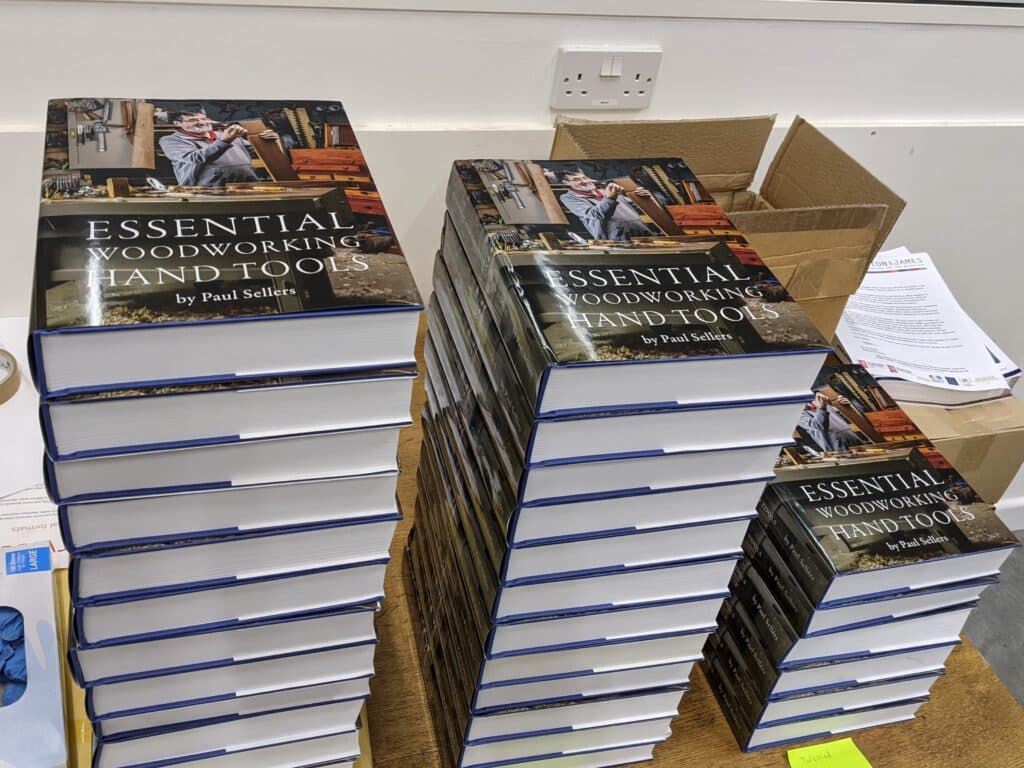
The reason I wrote my books, how-to booklets, blogs and magazine articles, started woodworking schools, created online classes in courses and took on a world full of woodworkers distracted by heavy machining methods was because I felt truly troubled that most of them just wanted a coffee table or a door and they fancied that they could probably make them if they had the right tools. Unfortunately, they considered the term tool to include space-hogging machinery. They simply didn’t know that they could make everything they needed with just hand tools. For me, I didn’t know I couldn’t turn the tide with my theory of three joints and ten hand tools so I did it. There is no substitute for developing and owning real skills in woodworking. They can only enhance your life and the things you make along with self-satisfaction that can only be achieved by mastering what seemed at first to be impossible. It will cost you to get there, but the outcome is better physical and mental health, higher levels of fulfilment and more beyond you can have the kids with you in your workspace that has space for them. You can even listen to an LP without wearing ear phones that separate you from true corresponding with your work.
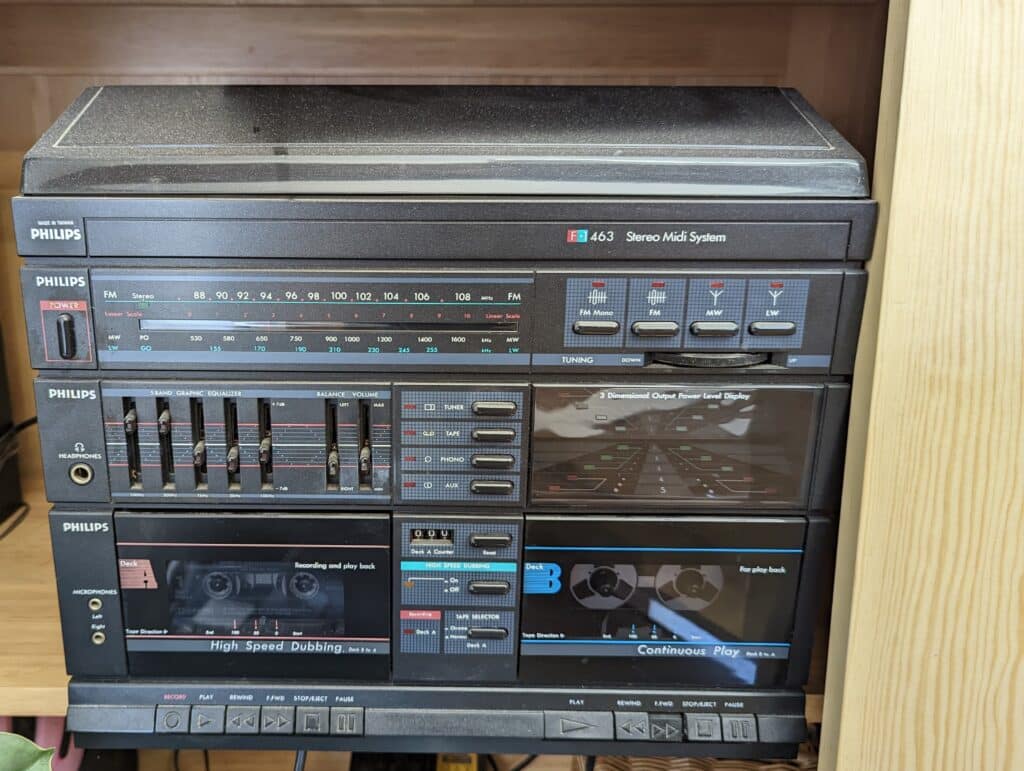
Therapies can come through various therapists, of course, they can and do, but, additionally, so many of you have written in and say that the best therapy you ever had was starting to work with wood. Therapy and professional support when done well is irreplaceable. We’re not talking about that here as that is out of my realm altogether.
On my health. Well, I am doing fine but with age can come some symptoms we may not want. I am surprised I have got this far living virtually pain-free except for any injuries ranging from some deep and larger splinters, many more than average to two cracked vertebrae in February this year. Covid injections and a bout of actual covid didn’t trouble me too much though I did have some shoulder aches after my first dose. I recently saw my chiropractor to deal with something I may have done to myself and maybe did not. Sometimes, 58 years of doing something one way can result in physical and mental harm. I’ve been a most fortunate man, my occupation took care of both. but though y hands still work great, I have something called a Dupuytren’s contracture, a disease that causes firm nodules which eventually appear in the ligaments just beneath the skin of the palm of the hand. In some cases, they extend to form cords that can prevent the finger from straightening completely.
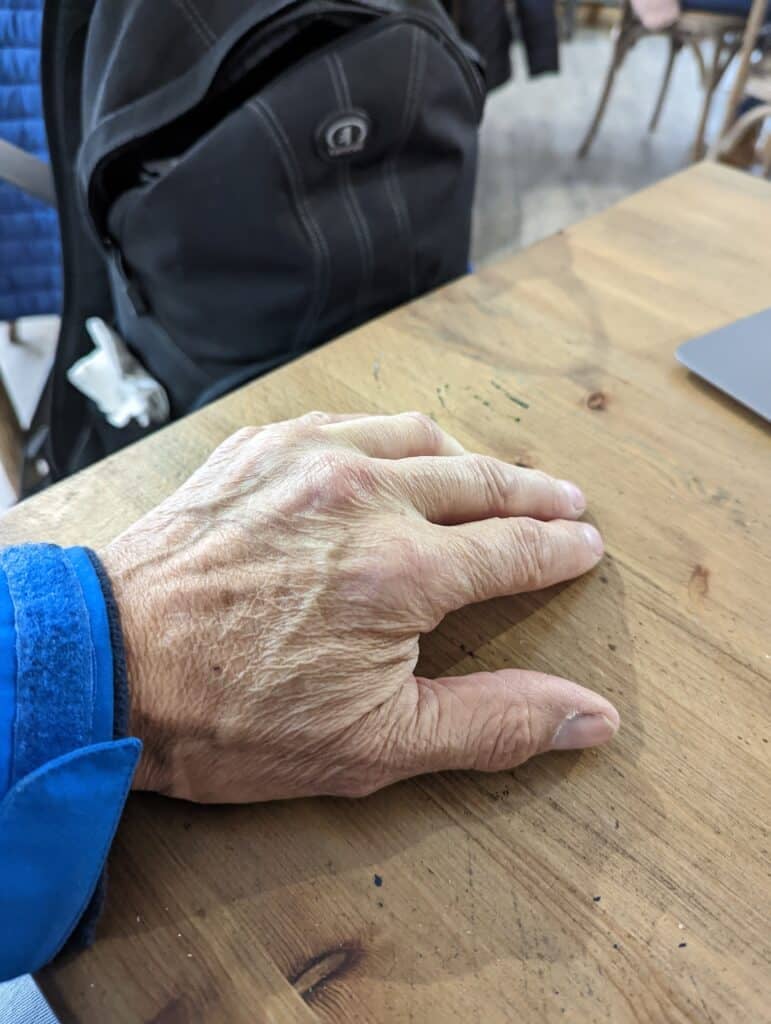
I can no longer lay my left-hand flat on a table and sometimes it gets in the way; mostly I find no obstruction and though I have seen it slowly develop for the last 16 or so years; I have probably had it longer than that.
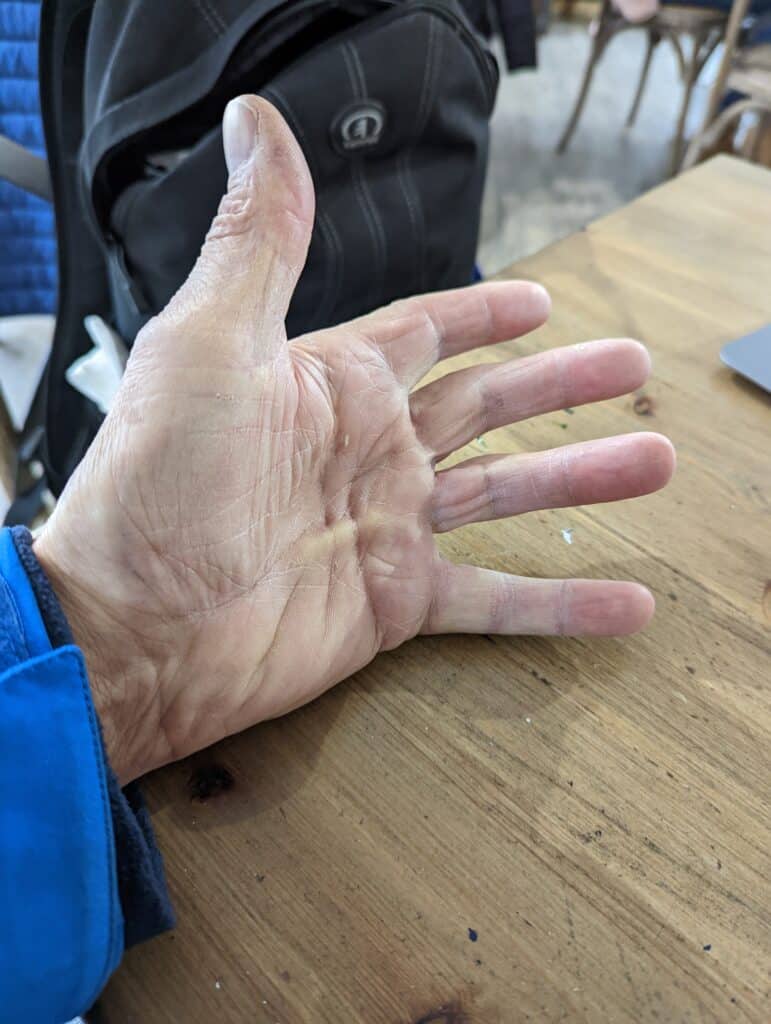
As for my being a long-term diabetic, my diabetes has caused me only minimal concern as according to my medical support my control is great even after so long a time of having it. This morning my self-test showed my blood sugar levels at 5.5.
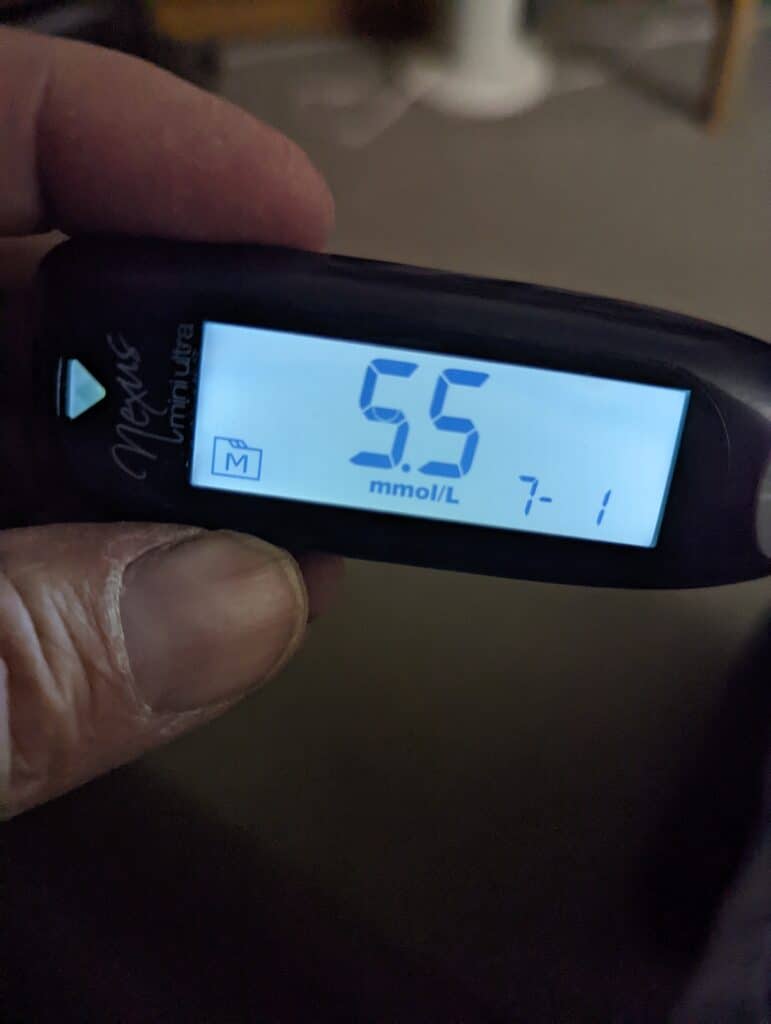
I am a third-generation diabetic so supposedly it’s in my genes. It has never stopped me from doing anything. I attribute this to my working physically and mentally too. Working and work ethic gives me great exercise every single day and my care with my diet helps me to manage my blood sugars really well. In general, I am pain-free almost all the time. Only when I exceed my body’s capacity do I find an overstrain. I always try to work safely but I am not risk averse because I love doing things that push me. So, my chiropractor believes in DIY. After one visit he gave me proactive work to do on my own. I do the added work and things get better. He then follows up with a check-up to see how things are progressing. My greatest ever periods of long-term pain came from extended use working with machines. Since I stopped machining wood on that scale over 30 years ago I have recovered remarkable health. Currently, I am working on a leg pain from something I did but which concurs with a thinning of the cartilage in one of my knees. Who knows where this will go but planing and sawing and so on seems to have helped me. To have reached nearly 73 this far with almost zero pain and never anything permanent seems pretty wonderful to me.


Hi Paul.
I have one of those Shinto rasps that I bought after you posted about them previously. Recently I needed two new file handles and could only get plastic ones which were stupidly expensive, but I found a broken yard-brush handle and decided to have a go at making my own handles.
I used the Shinto to reduce the diameter at the end to fit the scrap copper water pipe I made the ferrules from. It worked brilliantly and I was impressed by the control I got from the fine tooth side to get a nicely round profile which was a good and very tight fit in the pipe. Used the same tool to round over the other end of the handle and lightly hollowed the middle with the trusty spokeshave. Then about five minutes with a light hammer to peen the pipe over the end. I thought I’d have to dimple it with a punch to retain it but no need; it’s good and tight.
I’ve now made five – they take a bit less than half an hour each – and I have given away the plastic handles I had and didn’t like.
Thanks for your review of the Shinto. For what it’s worth I agree completely with you – I think it’s a great bit of kit.
By the way, I stumbled upon a thing called Synthetic Steel Wool which I’ve found terrific for a polished surface, even across the grain. It doesn’t leave any embedded steel debris to get rusty. It’s not cheap but it is tough and lasts well. Have you tried it and formed an opinion?
Good luck with your inevitable aches and niggles. I now have fairly severe arthritis in my left shoulder so there are a few things I no longer attempt. I can’t fire a shotgun, draw a bow or swing a golf club anymore but I don’t miss any of them. I can still saw with either hand (surprisingly) but the plane annoys the shoulder so I adapt so that I don’t need to plane left handed. So I can’t make the problem go away, but I can make the causes for it go away.
That’ll do!
Kindest Regards;
Rod.
I just found synthetic steel wool cheaply at Machine Mart UK.
Thank you Paul for putting a name to those pesky devils in my palm. I will need to remember Dupuytren’s contracture. When your knees get to the point of needing help I have a vast list of knee braces for you to try. Football in high school and college plus hard wood flouring projects over the years have rendered my knees rather irritated at me. As always I do enjoy your writings as well as woodworking advice. I would only add dowels to the above joint writings as boats of long ago were dowelled together.
It is a shame the Shinto doesn’t come in some kind of rounded version — at the same time, the more we can encourage skilled labor in the market, the better, so it’s not all loss. As good as the Shinto is for convex shapes, springing for a proper rounded Auriou (or peer) seems to be a necessity for shaping small curves well and quickly, such as profiled case feet. Ordered one today.
Paul,
The marking gauge that you show in your hand is amazing. I know that you have shown many times in writing and video how to make a marking gauge but nothing like the one you are holding. The thumb rest and the design like the Stanley 5061 is brilliant. It would be cool to have plans or a video for that design as I don’t recall ever seeing such a well thought out design for such a simple tool. Thanks for all the years of sharing.
Brett
Yes this is brilliant.
I wonder how was made the groove in the corner for the inlay.
There’s pretty good evidence that Dupuytren’s contracture is the likely historical/original reason for the gesture used by priests and bishops giving a blessing. If so, you are more than one kind of blessing to the hand woodworking world!
If your anecdote is correct, it’s one of the more interesting things I’ve learned in a while!
Hi Paul,
Sorry to hear about possible thinning cartilage in one of your knees. As a scientist in the biotech industry I read a lot of articles. Six months ago I read something that could be helpful if one of your kids could do some digging on the internet. It had been a long held assumption there was nothing that could be done when cartilage thinned. A hockey player had a hole in his. By eating certain things and doing some slow range of motion exercises, he was able to cause the hole in his cartilage to fill. The jist of the article was that research in medicine takes a could of years to make make it from journals to sorts medicine and then about 5 years to make it to conventional medicine. It’s possible there is something you can do to help your knees. I don’t recall what he was eating daily or the specific exercises he did.
Joe,
I’ve had a good search around to find the article you speak of, but can’t find it anywhere. I have had serious knee problems (cartilage being one) and would love to read more about the case you speak of. Are there any other clues to this particular article, maybe some keywords for searching or things to look up? Would be very grateful.
Cheers,
Rico.
Hi Rico
I can’t be sure, but it may be Connor McDavid (NHL ice hockey) – I found a documentary about his recovery from an awful knee injury without surgery
Hi Paul, I know whatever your ailments are you will still keep going. You are from the generation that didn’t let obstacles get in the way and you carried on regardless. Keep giving the knowledge of your experience to all your followers around the world. Who else would we turn to for traditional woodworking.
No plans to stop. Love my work too much and still too much to do yet to finish the work. I’m in surprisingly good shape, still riding my bike, doing squats, things like that and then spending time with nature looking into ponds and listening for wildlife all around me.
you do not have to buy As uriou or Logier hand stitched rasps
Lee Valley sell hand stitched rasps at 1/3 of the price made by a Czech company . They are excellent .
Good enough, but not up to the Auriou or a Logier. Still a decent rasp and if you don’t use a rasp much it will serve you well enough on a wide range of tasks.
that may sound strange, but you became a very important figure in my life, even my three little kids know who you are and are happy to see you on tv. I’ve been watching your video for a couple years now. I wish you many more years of woodworking and, honestly, when you will stop doing what you do, it may sound selfish, but there will be a serious void here. Thank you for everything you have taught me and still do!! out of subject, do you ever use blind dovetails? would love to see how to make those by hand !
I have done this on several projects on woodworkingmasterclass.com, our main teaching platform. It’s really not complicated to do but I will talk to the team to see what we can do about it to make a standalone video from my perspective.
sorry, English is not my mother tongue. I meant full blind dovetail, where the pins and the tails are not visible. I don’t know if it is a joint that is use very often, but it seem to be a tricky one!
Marc,
Secret dovetails are difficult to get right. Mitch Peacock has a really good video on these from a good few years back, reasonably in-depth. The concept is straight forward, just the execution a little harder than a dovetail. If you can do half-blind dovetails then you’re halfway there!
Rico
Thank you Rico! That was a nice video for a secret dovetail by hand. Need a couple of simple jig to guide the chisel. I understand that Mr Sellers does not see a shoulder plane as an essential tool, but it seem that you need one to cut that joint. I wonder if there’s a way to go around with another tool. Maybe one day, Mr Sellers will make that joint in one of his wonderful project! But for now, I’ll try Mr Peacock method with a bullnose plane.
bette davis once said “old age aint for sissies”. now that i am at that certain age where things i never thought of, now have to be taken into consideration, i can agree with her lol.
I know, I comment too much!
I can’t say enough about how the Poorman’s Toolset…the Bespoke Hand-Crafted, homemade, jim-dandy tools that Outperform the finest Lee Valley and *gasp* Lie Nielsen at 1/100,000th of price: pence, pennies, or Turkish lira. These super dialed in, Master-designed pieces are yours for the cost of some 4×2/2×4 pine, scrap steel, and sweat, my friends. The World’s Greatest Router! Why settle for anything less?
Side note: glad to hear you are fit as a fiddle, Mr. Sellers.
If your Dupuytrens gets any worse (and it likely will) I highly recommend the Pulvertaft hand clinic at Derby Royal hospital and particularly one consultant Mr Bainbridge. I suffered from it in my little finger which was bent to 90 deg, as I was working as a professional musician at the time it was crucial that I dealt with it. After most surgeries the condition eventually returns, after Mr Bainbridges thorough work 12 years down the line the finger is still perfectly straight.
As always it’s the quality of the craftsman not the tools that matter, surgeons maybe more-so.
Thank you, Phil. I checked the site and will likely be in touch with them. And good to hear of your successful outcome. This really has not bothered me thus far but I can see myself tucking it out of the way more nowadays. having had such a trouble-free life thus far I feel guilty to even mention these small life contractions but my hands and my hand work rely so much on good flexibility. that said, if I couldn’t do it tomorrow I cannot complain. 58 years in the saddle is a really good innings.
Paul, If you get the right specialist surgeon and get the gold standard procedure (not just cutting the cord or use of dissolving chemicals ) you will be back working pain free and with good mobility in a few weeks. Don’t allow the procedure to be carried out by a general surgeon who maybe only does one a month,
Done correctly it takes about 15 minutes with a local anaesthetic.
For those who can afford it I believe Mr Bainbridge also has a good private practice although he did mine as an NHS patient.
Can I just add to this that a friend of ours recently had this operation. After years of the GP saying it wasn’t bad enough to refer on, the surgeon felt he should have seen it much sooner and had to do a much bigger operation as a result. I think it’s worth speaking to a surgeon to get their expert opinion on it at least
The problem is the NHS guidance for GP’s seems to require that a finger is bent to 90 deg before they can refer, at least that was the situation 10 years ago. I doubt things will have since improved with NHS referrals.
Of course you can self refer as a private patient and be seen within days and at least get an expert opinion for a one off consultancy cost, normally under £200.
Curious if you’ve had a chance to try out some of the iwasaki carving files yet?
Watching a guitar maker try some out and then picking up his lovely auriou hand stitched rasp and you could hear the inner monologue: “I wish this was clearly better than those damned things” as he tries the rasp and the iwasakis a few more times.
I really regret not grabbing a set of the iwasaki floats when I had a chance because they’re damn near impossible to find anymore.
Paul, I’ve looked everywhere for your book, beginning on your website. I consider myself relatively adept technically but I couldn’t find a buy option. Seeing the photo of the stack of them here (surely an older photo) made me think it might be worth asking directly if it is still for sale; so, is it? And if so, where?
Thank you for sharing your wealth of knowledge and wisdom
Brian
There are a few left. Not many though. here is the link where you can buy from our company Rokesmith. It’s the only outlet
where it is available. https://rokesmith.com/product/essential-woodworking-hand-tools-book/